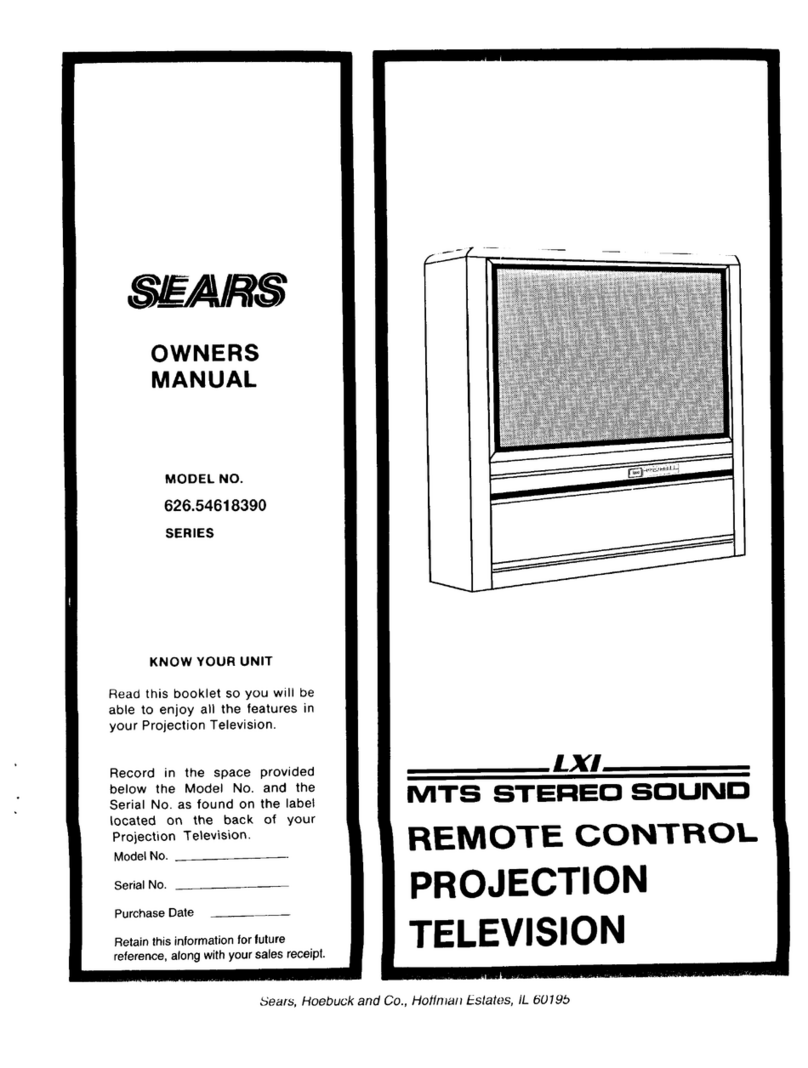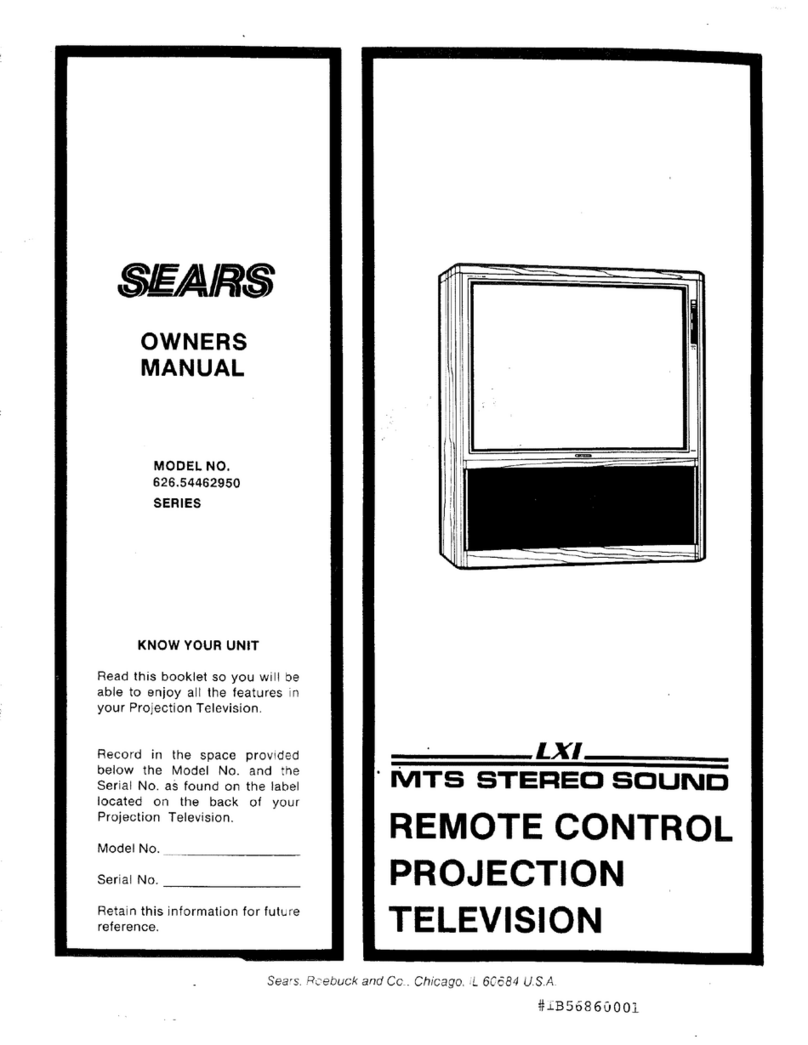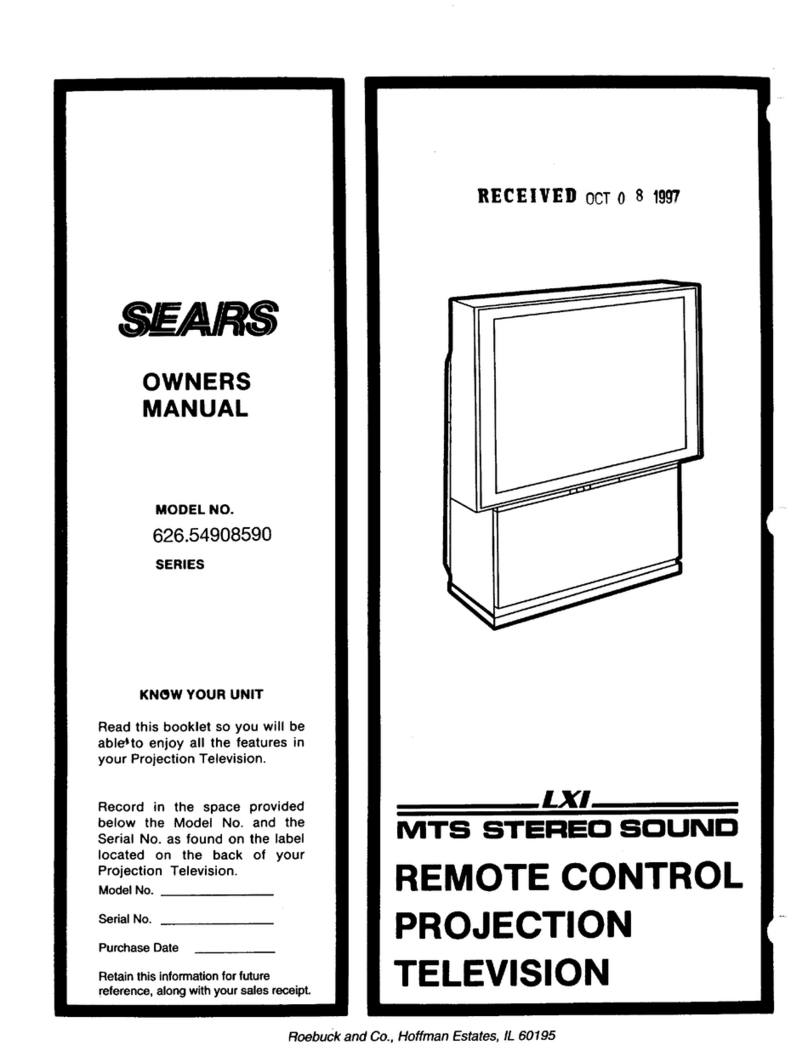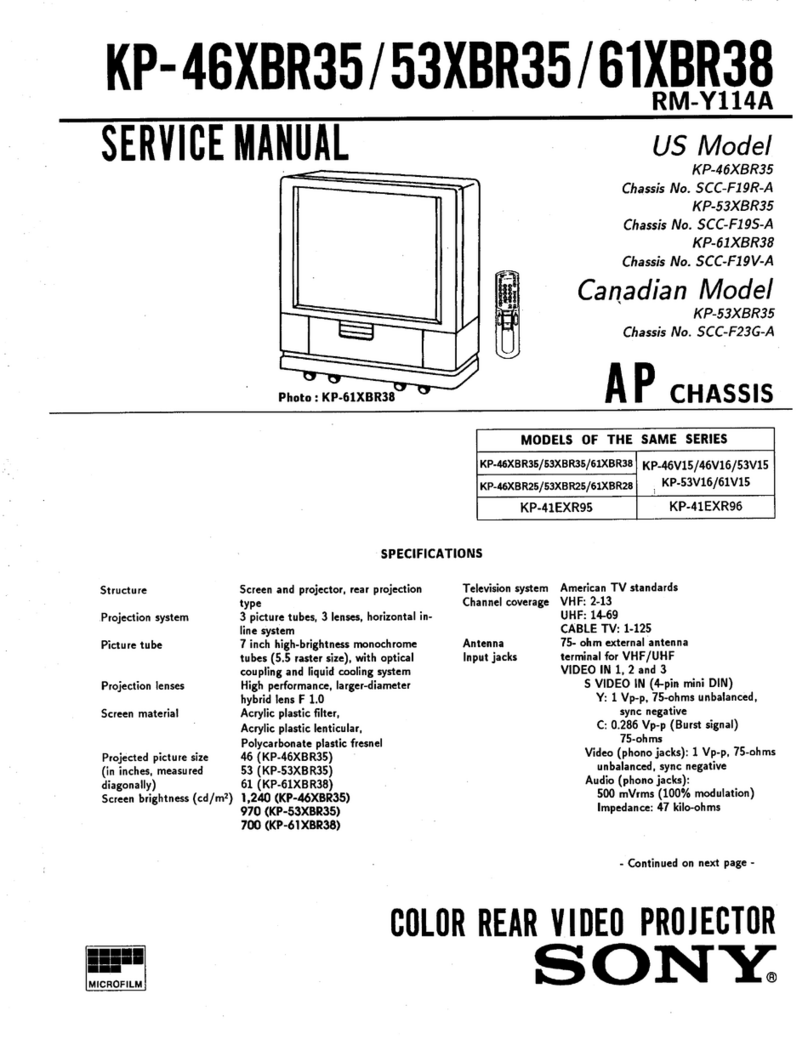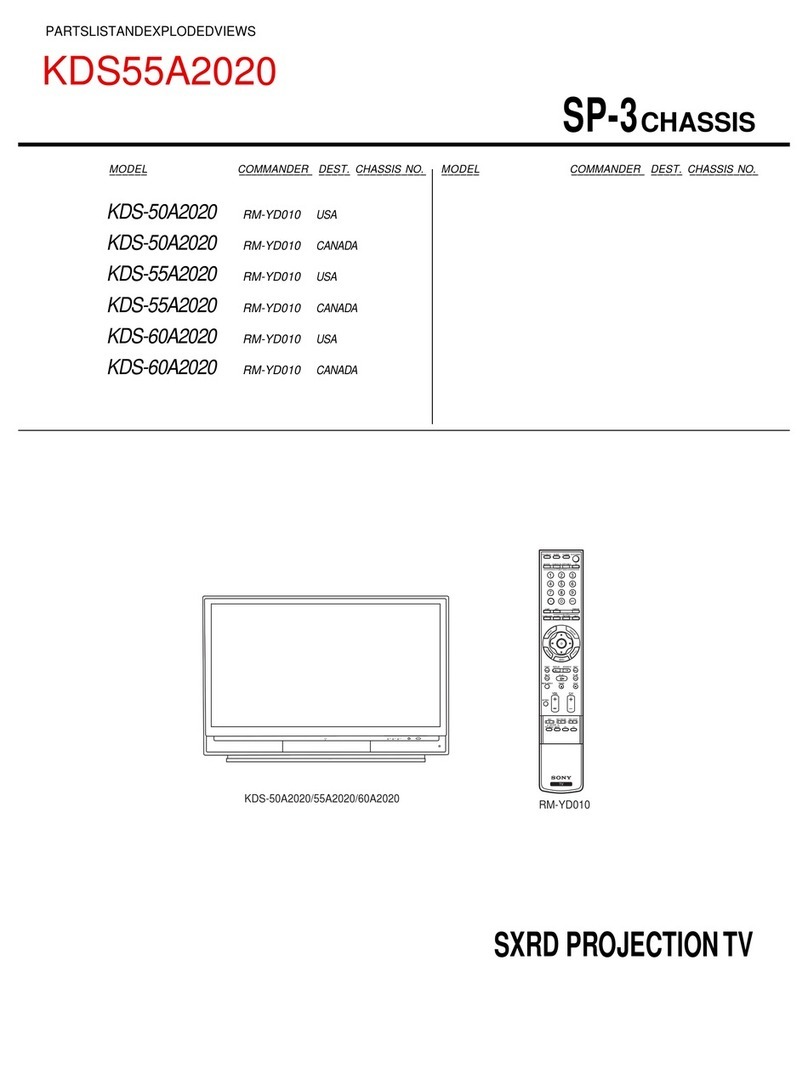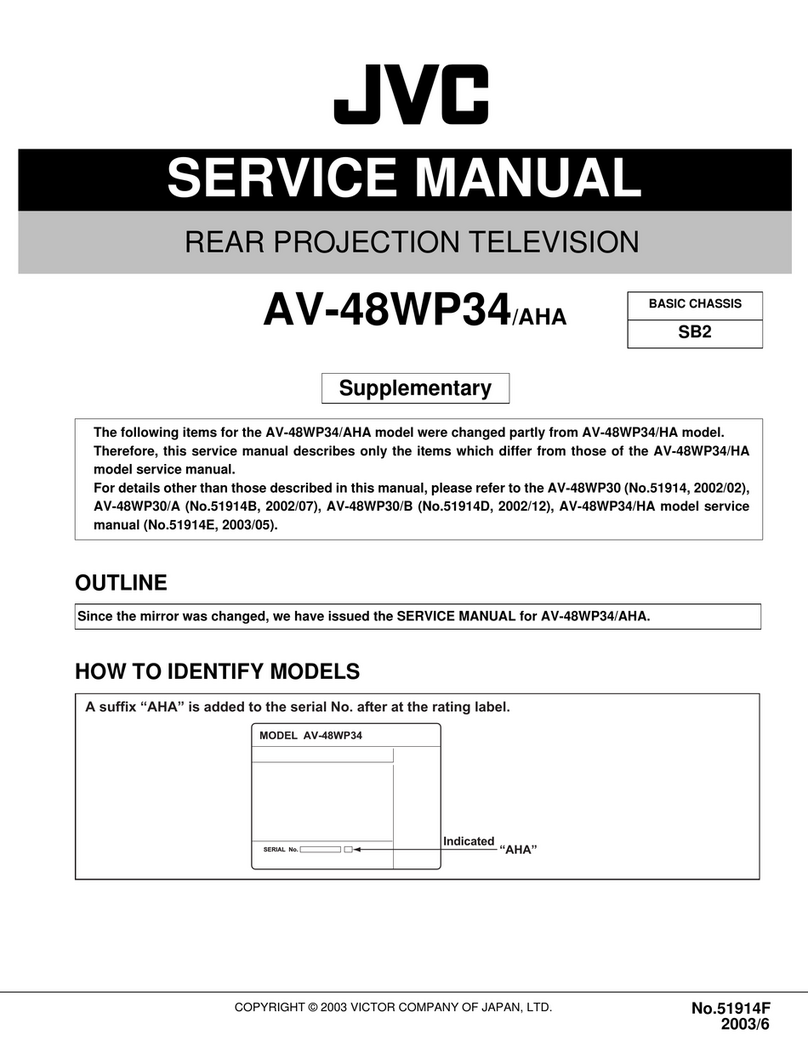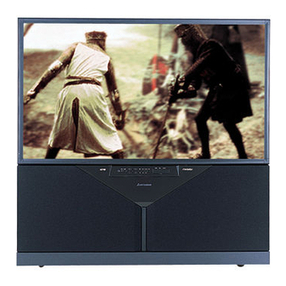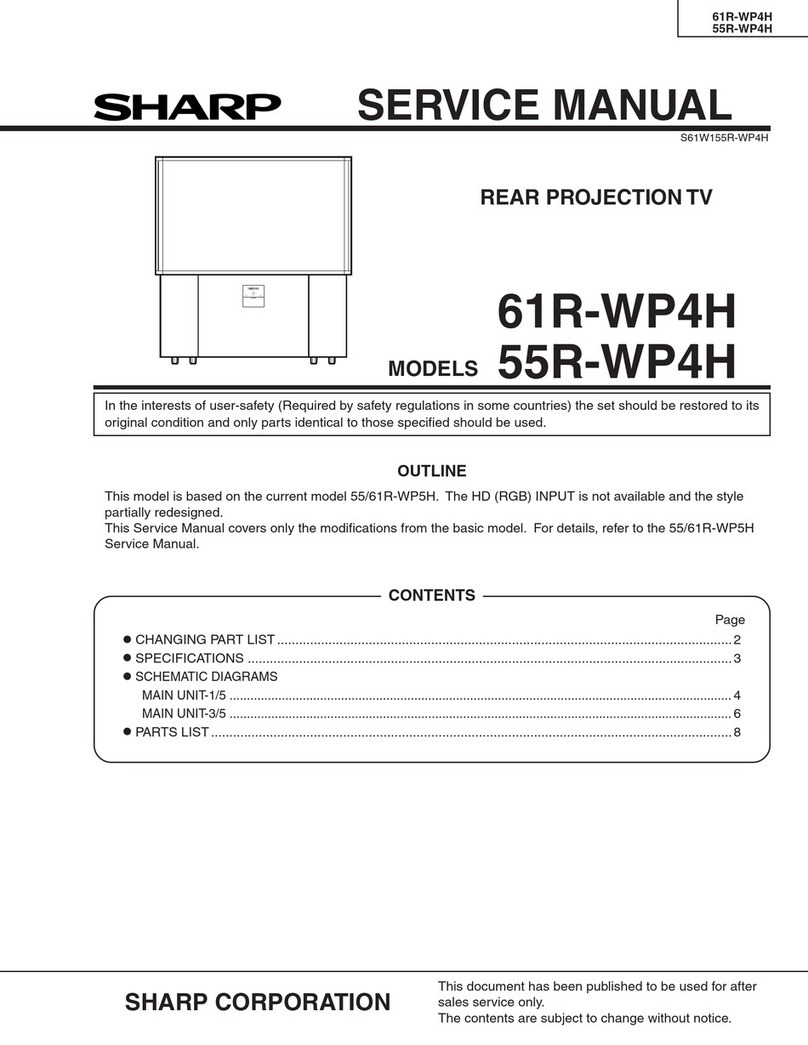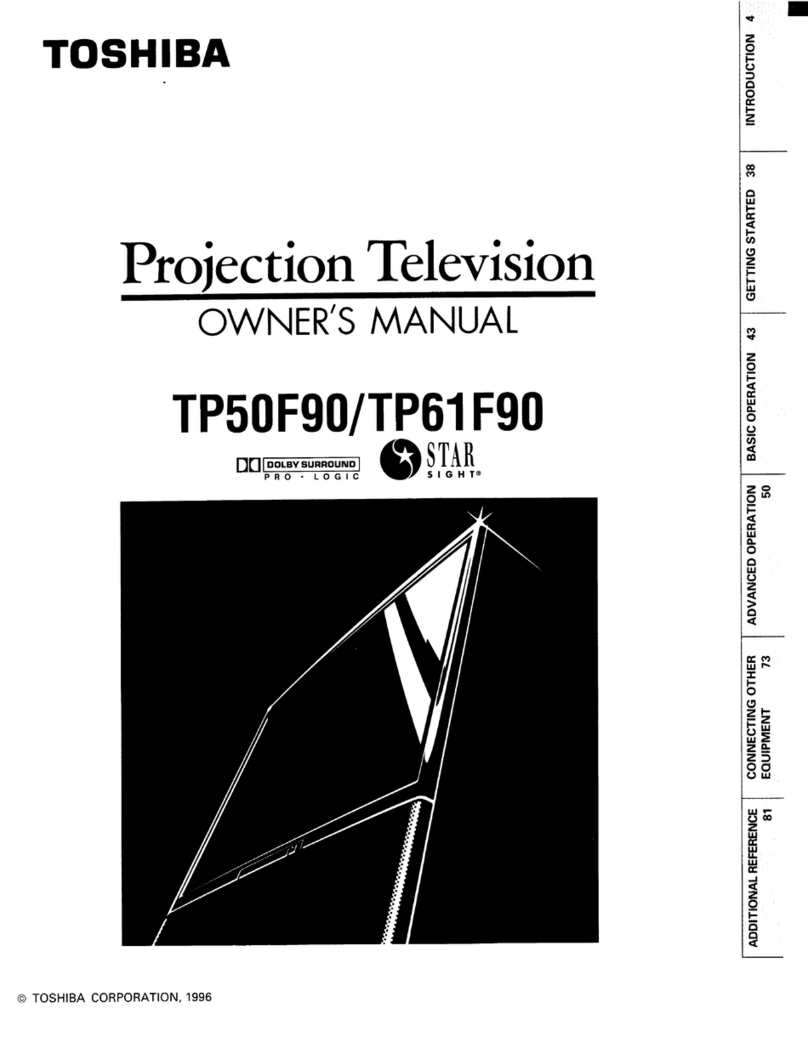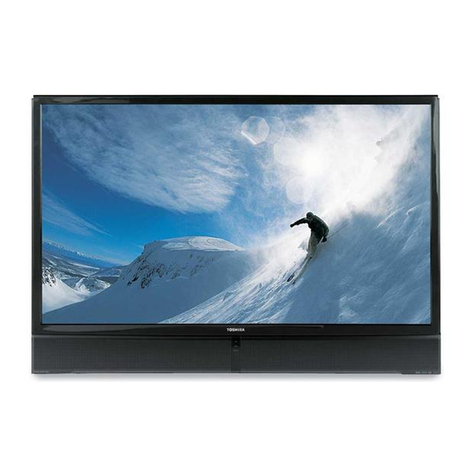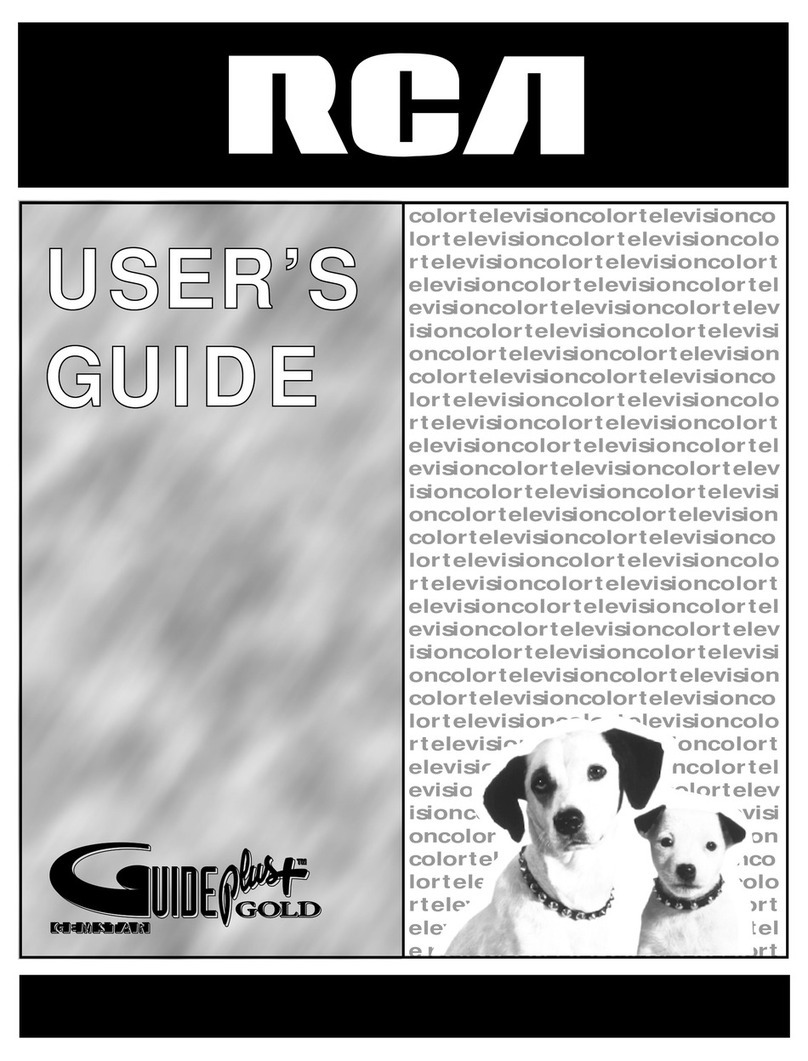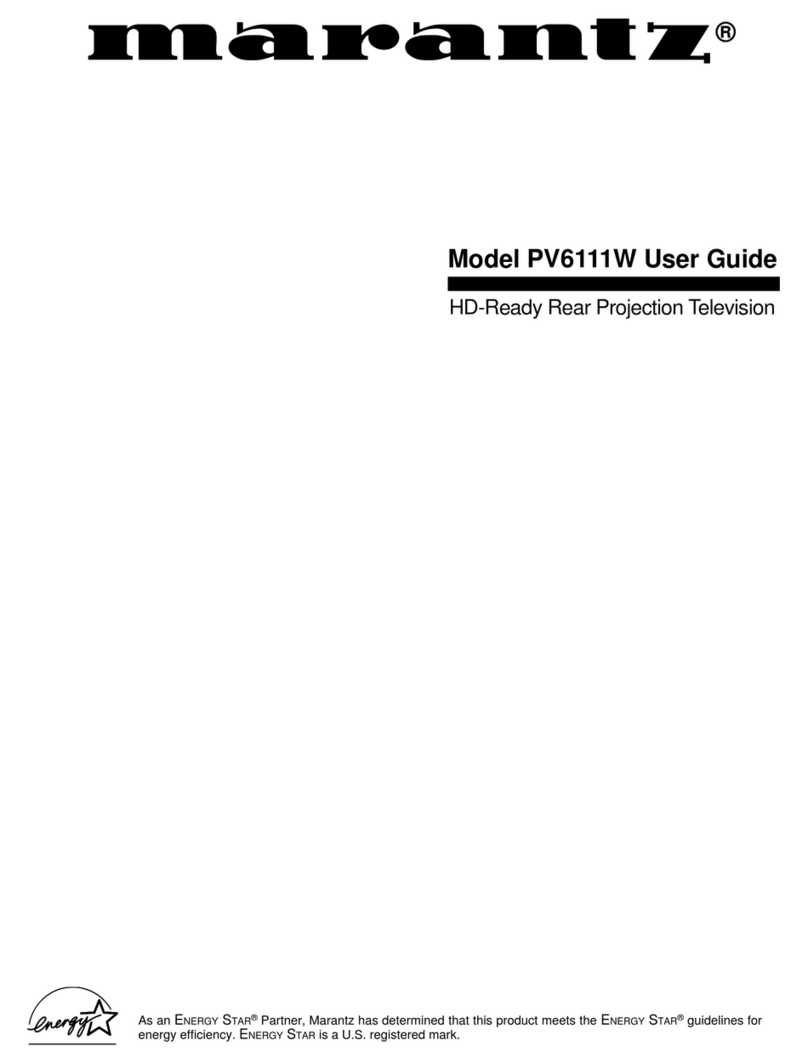Sears 626.54528690 Series User manual

, =/AUR8
OWNERS
MANUAL
MODEL NO.
626.54528690
SERIES
KNOW YOUR UNIT
Read this booklet so you will be
able to enjoy all the features in
your Projection Television.
Record in the space provided
below the Model No. and the
Serial No. as found on the label
located on the back of your
Projection Television.
Model No.
Serial No.
Purchase Date
Retain this information for future
reference, along with your sales receipt.
LXI _-.....................................
_-STEREO SOUND
REMOTE CONTROL
PROJECTION
TELEVISION
Sears, Roebuck and Co., Hoffman Estates, IL 60195

To cu,,,mc that plctmc screen perfom_ance i,',of tile Ilighest quality, avoid rubbing any object or material on the sctccn that could scr,ttch
or danlage its surface.
When cleaning the TV screen take care not to scratch or damage the screen surface (avoid wearing jewelry or using anything abrasive).
CAUTION: A video source (such as a video game, Compact Disc Interactive - CD-i, or TV information channel) which shows a
constant non-moving pattern on the TV screen, can cause picture tube damage. When your TV is continuously used with such a source
the pattern of the non-moving portion of the game (CD-i, etc.) could leave an image permanently on the picture tube. When not in use,
turn the video source OFF. Regularly alternate the use of such video sources with normal TV viewing.
If an outside antenna is connected to the television
receiver, be sure the antenna system is grounded so as
to provide some protection against voltage surges and
built up static charges. Section 810 of the National
Electrical Code, NFPA No. 70-1975, provides GROUND CLAMP
information with respect to proper grounding of the
mast and supporting structure, grounding of the lead-
in wire to an antenna discharge unit, size of grounding
conductors, location of antenna-discharge unit,
connection to grounding electrodes, and requirements
for the grounding electrode.
NOTE: It is essential that any TV signal lines that are _
to enter the home be grounded at the exact same point
as the power service grounding. This applies
regardless of any other grounding to those systems.
NOTE to CATV System Installer: /
I
This reminder is provided to call the CATV system
installer's attention to Article 820-40 of the NEC that _.,
provides guidelines for proper grounding and, in ELECTRIC
particular, specifies that the cable ground shall be SERVICE
EQUIPMENT
connected to the grounding system of the building as
close to the point of cable entry as practical. NEC-NATIONALELECTRICALCODE
-- ANTENNA LEAD
IN WIRE
ANTENNA
DISCHARGE UNIT
(NEC SECTION 810-20)
GROUNDING CONDUCTORS
(NEC SECTION 810-21)
GROUND CLAMPS
POWER SERVICE GROUNDING
ELECTRODE SYSTEM
(NEC ART 250. PART H)
WARNING: TO PREVENT FIRE OR SHOCK
HAZARD DO NOT EXPOSE THIS UNIT TO
RAIN OR EXCESSIVE MOISTURE.
The lightning Dash with arrowhead syn',bol, within an equilateral
triangle is intended to alert the user of the presence of
uninsulated "dangerous voltage" within the product's enclosure,
that may be of sufficient magnitude to constitute a risk of
electric shock to persons.
The exclamation point within an equilateral triangle is intended
to alert the user of the presence of important operating and
maintenance (servicing) instructions in the literature
accompanying the appliance.
2

SAFETYINSTRUCTIONS- Readbefore operating equipment
This product was designed and manufactured to meet strict quality and
safety standards. There are, however, some installation and operation
precautionswhich you should be particularly aware of.
1. Read Instructions - All the safety andoperating instructions should
be readbeforethe appliance is operated.
2. Retain Instructions - The safety and operating instructions should
be retainedfor future reference.
3. HeedWarnings- All warnings on the appliance and in the operating
instructions should be adheredto.
4. Follow Instructions - All operating and use instructions should be
followed.
5. Water and Moisture -The appliance should not be used near water
- for example,near a bathtub, washbowl, kitchen sink, laundry tub,
in a wet basementor near a swimming pool, etc.
6. Carls andStands-Theappliance should be used only with a cart or
stand that is recommended bythe manufacturer.
6A. _ An appliance and cart combination should be moved
with care. Quick stops, excessive force, and uneven
surfaces may cause the appliance and cart combination
to overturn.
7. Wall or CeilingMounting - The appliance should be mounted to a
wall or ceiling onlyas recommended by the manufacturer.
8. Ventilation -Theappliance should besituated so that its location or
position does not interfere with its proper ventilation. For example,
the appliance should not be situated on a bed, sofa, rug, or similar
surface that may block the ventilation openings; or, placed in a
built-in installation, such asa bookcaseor cabinet that may impede
the flow of air through the ventilation openings.
9. Heat - The appliance should be situated away from hear sources
such as radiators, heat registers, stoves, or other appliances
(including amplifiers) that produce heat.
10. Power Sources-The appliance should be connected to a power
supply only of the type described in the operating instructions or as
markedon the appliance.
11. Power-Cord Protection - Power supply cords should be routed so
that they are not likely to be walked on or pinched by items placed
upon or against them, paying particular attention to cords and
plugs, conveniencereceptacles, and the point where they exit from
the appliance.
12. Cleaning-The appliance should be cleanedonly as recommended
bythe manufacturer.
13. Power Lines - An outdoor antenna should be located away from
power lines.
14. Outdoor AntennaGrounding- If an outside antenna is connectedto
the receiver, be sure the antenna system is grounded so as to
provide some protection against voltage surges and built up static
charges.
Section 810 of the National Electric Code,ANSI/NFPA No. 70-1984,
provides information with respect to proper grounding of the mats
and supporting structure grounding of the lead-in wire to an
antenna discharge unit, size of grounding connectors,location of
antenna-discharge unit, connection to grounding electrodes and
requirements for the grounding electrode. SeeFig.below.
15. Non-use Periods - The power cord of the appliance should be
unplugged from the outlet when left unused for a long period of
time.
16. Object and LiquidEntry - Careshould be taken so that objects do
not fall and liquids are not spilled into the enclosure through
openings.
17. Damage Requiring Service -The appliance should be serviced by
qualified service personnel when:
A. The power supply cord or the plug has beendamaged;or
B. Objects have fallen, or liquid has been spilled into the
appliance;or
C. Theappliance has been exposedto rain; or
D. The appliance does not appear to operate normally or exhibits
a markedchange in performance; or
E. Theappliance has been dropped, or the enclosure damaged.
18. Servicing - The user should not attempt to service the appliance
beyond that described in the operating instructions. All other
servicing should be referred to qualified service personnel.
Note to the CATVsystem installer: This reminder is provided to call the
CATV system installer's attention to Article 820-40 of the NEC that
providesguidelines for propergrounding and, in particular,specifies that
the cable ground shall be connectedto the grounding system of the
building, as closeto the point of cable entry aspractical.

iGetting Started
Welcome/Product Rcgisu alton ................... 2
Safety/Precautions ..................................................... 3
Table of Contents ....................................................... 4
Features and Model Information ................................ 5
_-_ On-Screen Features
PICTURE MENU
+Adjusting Color, Brightness, Sharpness,
Tint, and Picture Controls ................................... 6
+Using the Clearview Control ............................... 7
+Using the Flesh Correction Control .................... 7
+Adjusting the TV's Convergence Control ........... 8
FEATURES MENU
+Selecting a Picture Source/RF Switcher ............. 9
+Setting the TV for Closed Captioning ............... 10
+Setting the TV for Cable or Antenna Signals....11
+Adding Channels in Memory (Automatically) .12
+Adding Channels in Memory (Manually) ......... 13
+Setting the TV Clock ......................................... 14
+Turn-On Timer .................................................. 15
+Using the Sleep Timer Control ......................... 16
+Using the Time/Channel Reminder Control ...... 17
+Using the Parental Control ........................... 18-19
+Adjusting the Channel Display Control ............ 20
+Using the Language Control ............................. 21
SOUND MENU
+Adjusting Sound Balance Control .................... 22
+Setting the TV for Stereo and SAP Programs ..23
+Using the Sound Image Control ........................ 24
+Using the Volume Display Control ................... 25
+Using the TV Speaker On/Off Control with
the Audio Output jacks ..................................... 26
+Using the Rear Surround External Speaker
connection ......................................................... 27
+Using the TV's Audio/Video Input and
Output Jacks ............................................... 28-29
Gem:ral Information
Tips if Something Isn't Working ............................. 30
TV Help Menu ......................................................... 31
Glossary of TV Terms ............................................. 32
Index ........................................................................ 33
Sears Repair and Service Center Information .......... 34
Warranty .................................................................. 36
I

First Time _l't lip - ,mtom__ltncall_ _,cts tilt: IV hn
local channels and the correct picture signal (antenna
or cable). See your Set-up and Quick Use Guide for
details.
Infrared Remote Control - operates your TV and all
on-screen feature controls.
Standard TV broadcast (VitF/UI-IF) or Cable TV
(CATV) channel capability.
Closed Captioning -allows the viewer to read TV
program dialogue or voice conversations as on-screen
text.
Automatic Programming of channels - for quick
and easy selection of favorite stations available in
your area.
Stereo-Ready TV - with a built-in audio amplifier
and a twin speaker system, reception of TV programs
in both broadcast stereo sound or (SAP) bilingual
broadcast are available.
On-Screen Features - display helpful information
for the selling of TV controls (such as help messages,
operating tips and glossary).
Parental Controls - for "censoring" or blocking out
channels I(1 keep children from watching undesirable
programming.
Audio/Video Jacks - for direct connections with
VCRs (and other accessories) for quality TV picture
and sound playback.
Sleep-Timer - automatically turns the TV OFF at
preset time intervals.
As you unl)ack yore TV please note that the h)l-
lowing items have been included with your set:
• Owner's Manual
Safety Tip Information
• Remote Control Transmitter
• Batteries for Remote Control Use
The serial number for the TV is on the back of the
set.
To ensure that picture screen performance is of
the highest quality, please avoid rubbing any
object or material on the screen that could scratch
or damage its surface.
Refer to the back of this manual for instructions
on the cleaning and care of the TV.

_u adju,_l );out JV colol alal
picture controls, select a TV
channel and follow the steps shown
below:
<_ Select BRIGHTNESS, PIC-
TURE, COLOR, TINT, or
SHARPNESS picture control.
With the PICTURE MENU on
screen, move the RED highlight to
the feature you would like to adjust
with the CHANNEL • or • and
the VOLUME + or - buttons. Then
press the MENU button.
_,' _ Press the VOLUME + or -
button to adjust the selected con-
trol.
<_ Press the STATUS button to
I clear the screen.
Remember. When the
gbar scale is centered, control
settings are at normal mid-range
levels.
BRIGHTNESS Press (-) or (+) until
dark parts of the picture show good
detail.
PICTURE Press (-) or (+) until
whitest parts of the picture are as
bright as you prefer.
COLOR Press (-) or (+) to add or
eliminate color.
Press (,-')or (,÷)to obtain natu-
ral skin tones. (Also see Flesh
Correction on page 9 for more infor-
mation).
Press (-) or (+) to
improve detail in the picture.
MAIN MENU _:
1 OF2_
Select andthen press I
MENU (M) button to
view an explanation of
the selected feature.
Select and then press MENU
(M) button to view additional
controls grouped under same
feature heading. For
Example: Tint, Brightness,
Picture, etc.
HOW q'O SELECT FEATURES
(WITH BUTFONS ON THE REMO'I,'E)
Press MENU to
select RED high-
lighted feature. Press CHANNEL
• • to move Up
and Down within
the Menu.
Press VOI.U ME + or -
"tO n_ove _?rotl_ Side-_o
Side _,ithin "the h,_e_u.
6

'_/('(Jl view 13 1.1 shart);_t'._._ jcalure
which smoothes out back-
ground snow (or picture noise)
without losing picture image detail
or crispness.
<_ Select CLEARVIEW control.
With the PICTURE MENU on
screen, move the RED highlight
with the CHANNEL • or • and
the VOLUME + or -buttons. Then
press the MENU button.
<_ Press the CHANNEL • or •
buttons to move the RED highlight.
Press the MENU button to select
(tl) the ENHANCED mode.
<_ Press the STATUS button to
I clear the screen.
se the Plesh Correction con-
trol to keep skin tone hues (or
facial tint)from varying from TV
channel to TV channel.
<_ Select FLESH CORREC-
TION control.
With PICTURE MENU (2 of 2) on
screen, move the RED highlight
with the CHANNEL • or • and
the VOLUME + or - buttons. Then
press the MENU button.
<_ Press the CHANNEL • or •
buttons to move the RED high-
light. Press the MENU button to
turn (t,,")the FLESH CORREC-
TION control ON.
<_ Press the STATUS button to
clear the screen.
x::+>:+:.+:.:
......._:_idiiiiiiiiiiiiiiiiiiiiiiiiiiiiiiii
MAIN MENU ......!:_iiiiii_:_ _:_;:i:::::::::':r:::_:_: ::::::
7
I
,' PICTURE MENU o
• 20F2 .......
_.....,...:?+ ,. ,:..:_?;;:_....
• •FLESH "". " '
___-.._
n_r _" _ _ _i_!_:_._
-- _:_ ,,.........:.:.:.:_..:.:.:::_,_;._._::

t)tt vet _ok'd is lhe _o; Iccl /ltl-
ing up of the red and blue
light paths on the TV screen.
NOTE: If no color fringing (see
Smart Help) shows, then no
Convergence adjustments are nec-
essary for your TV.
<_ Select CONVERGENCE con-
trol.
With PICTURE MENU (2 of 2) on
screen, move the RED highlight
with the CHANNEL • or •and
the VOLUME + or - buttons. Then
press the MENU button.
<_If there is RED or BLUE color
fringing on the White cross, press
the MENU button to continue.
_ Press the CHANNEL • or •
and the VOLUME + or - buttons
to move the red or blue cross
directly over the white cross on the
TV screen.
The red or blue cross is properly
adjusted when it is completely
merged with the white cross. (No
color appears around the edge of
the white cross).
<_ Press the STATUS button to
clear the screen when convergence
adjustments are complete.
J'(t21|lclll bCY. _OllV Cl gCllCt_
ghas been set at the factory for
best viewing, but if one or more of
the (red or blue) colors appear
around the edges of objects (color
fringing) follow the steps given in
this section.
<
PICTURE MENU
PICTURE MENU
2 0F2_
If there is RED or BLUE
fringe on the WHITE cross,
use this adjustment to
improve the picture.
Press "M" to Continue
-or -
Press "IP"to Return
1
t
H
_keys to merge the
I RED fringe into the WHITE
J cross. Press "M" to Continue.

Select PICTURE SOURCE
SEI,ECT control.
With the FEATURES MENU on
screen, move the RED highlight with
the CHANNEL • or • and VOL-
UME + or - buttons. Then press the
MENU button.
<_3_ Press the CHANNEL • or I!'
buttons to move the RED highlight.
Press the MENU button to turn the
desired PICTURE SOURCE control
ON (_").
ANTENNA- for a picture signal
coming from the ANTENNA
plug on the TV.
VCR/AUX- for a picture signal
coming from the Video Input
jack on the rear of the TV.
<_ lPress the STATUS button to clear
the screen.
<
MAIN MLNU .....i:_ii. :::if::
"-FEATU_-';'_: E£I
EXIT
iiiiiiiiiiiiiiiii!!!!!!iiiiiiiiiiiiiiiiiii FEA]IJFIE MENU
[!i!_iiii::i::_::_iiiilHi_ , _ , o,t,
....i:_iii::iii!iii:: -_SOUR_ -
•._ _._'_-_
1 OF3,
•.i:: :_
•_:L.
V_9/AUX 1
...._;_::::"._:L.._.;_
r":. ":qii:::::::::
__ • L
Remember.
The VCR/AUX
TV screen will
be blank unless a
signal source is
connected to the
Video Input jack
on the rear of the
TV. (See page 28
for details).
n optional 14P 3wltcher is uv_,tat)le
that will allow an Antenna/Cable TV
signal and another video accessory
'VCR. Video Disc Player, etc.) to be
connected to the TV at the same time.
Connection instructions are given with
'he accessory RF Switcher, but be sure
to turn the TV's power OFF (and
unplug itsAC power cord) when con-
necting the RF Switcher to the RF
Switch Input jack on the rear of the TV.
Replug the TV's AC Power Cord into
the wall outlet and turn the TV ON. The
TV' s Picture Source Menu will now
show an Accessory Signal Source option
available for selection.
Contact you nearest Sears Repair
Department for more information on the
accessory RF Switcher.

lO.sedCaptiontLtt_, (C'C') allow,_
ou to read the voice content of
television programs on the TV
screen. Designed to help the hearing
impaired this feature uses on-screen
"text boxes" to show dialogue and
conversations while the TV program
is in progress.
Select CLOSED CAPTION-
ING control.
With the FEATURES MENU on
screen, move the RED highlight
with the CHANNEL • or • and
the VOLUME + or - buttons. Then
press the MENU button.
<_ Press the CHANNEL • •
or
buttons to move the RED highlight.
Press the MENU button to select
(t,,") the desired Closed Caption
mode - For Example: "ALWAYS
ON" and "CAPTION 1".
CAPTION 1, 2, 3, 4:
dialogue (and descriptions)
for the action on the captioned
TV program shows on-screen.
(See Important Note on this
page.)
TEXT 1,2, 3, 4:
often used for channel guide,
schedules, or bulletin board
information for CC programs.
<_ After making your Caption mode
selection, press the STATUS button
to clear the TV screen. The selected
Closed Caption mode will be active.
To cancel, set the Closed Captioned
feature to OFF when finished view-
ing.
Rcnlcnlbcr. Broadcast
g stations will often use
spelling abbreviations, symbols,
dropouts and other grammatical
shortcuts in order to keep pace
with the on-screen action. These
type factors vary upon the source
of the captioned text material and
do not indicate a need for service
on the part of the TV.
<
NOTE: Not all TV programs and product commercials are made for broadcast
with Closed Caption (CC) information included. Neither are all Closed Caption
modes (CAPTION 1-4; or TEXT 1-4) necessarily being used by a broadcast station
during the transmission of a closed caption program. Usually "CAPTION 1" is the
most used mode to view captioned material. Refer to your area's TV program list-
ings for the stations and times of Closed Caption shows.
,,,++iiiiiiiiiil
NOTE: The ON DUR-
ING MUTE ONLY
control can be used to
set the TV to turn the
Closed Caption mode
'_ON" whenever the
MUTE button on the
remole is pressed.
+++iii+++++Mii+iiiiiiiii+iii...........
FEATURE MENU
1 0F3_
E] ALWAYS ON
ALWAYS OFF
ON DURING MUTE ONLY
0 TEXT,
CAPTION 2 TEXT 2
| | CAPTION 3 TEXT 3
I I CAPTION 4 TEXT 4
Closed Caption information will usually appear
in black and white (although some broadcasters
or networks may occasionally use color to hi
light or draw attention to certain areas.)
I| This symbol will appear on channels that con-
rain Closed Captioning material whenever the
status display is shown.
CAPTION I mode
Example Screen Display
I:ULL. SCREISN 'i LX'I
will block TV screen from viewing
12:00
lO

'11L lJ you _cm ttu uugh
rst Time Setup (in your
Quick Use Guide), this task has
already been completed for you.
You need to make sure the TV is
set to pick up either Cable TV or
Antenna signals. In other words,
the TV needs to know if you con-
nected a Cable TV signal or a nor-
mal antenna to its ANTENNA plug.
<_ Select CABLE CHANNEL
TUNING control.
With the FEATURES MENU on
screen, move the RED highlight
with the CHANNEL • or •and
the VOLUME + or - buttons. Then
press the MENU button.
<_ Press the CHANNEL or
buttons to move the RED high-
light. Press the MENU button to
select (t,,_) the desired mode - For
Example: CABLE.
CABLE-
NORMAL-
If you DO have
Cable TV connected
to the TV. Channels
1-125 are available.
If you have an
Antenna connected
to the TV. Channels
2-69 are available.
Press the STATUS button to
clear the screen.
' MAIN MENU,
,i rI'I'
10F3_
CABL
D NORMAL
11

O71s. lj you went thruugh k irst
Time Setup (in your Quick Use
Guide), this task has already been
comple ted for you.
Your TV can automatically set itself
for local area (or Cable TV) chan-
nels. This makes it easy for you to
select only the TV stations in your
area when the CHANNEL • V but-
tons are pressed.
<_ Select CHANNEL MEMORY
(START AUTO-PROGRAM-
MING) control.
With the FEATURES MENU on
screen, move the RED highlight with
the CHANNEL •or •and VOL-
UME + or - buttons. Then press the
MENU button.
<_ Press the MENU button to turn
AUTO-PROGRAMMING ON.
The TV shows which channel num-
bers are "SAVED" (tl) as they are
added into memory.
"Auto-programming CHANNEL
MEMORY is finished" shows when
the TV is through adding channels.
<_ Press the STATUS or Menu but-
ton to clear the screen.
Try it out. Press lhc
CHANNEL&• buttons and
see which channels you can select.
Remember. An Antenna or Cable TV
signal must first be connected to your
TV so that channels can be saved.
If you want to delete any unwanted
channels from the TV's memory, see
"ADD/DELETE CHANNELS" on
page 13.
' MAIN MLNU,
_FEATUREMENU
©©
t.," Channel Numbers are
Saved in Memory
AUTO_ROGRAMMING
CHANNEL MEMORY
1 2,/ 3_ 4,/
5v" 6,/ 7,/ 8_
9_' 10 11 12
13 14 15 16
17 18 19 20
21 22 23 24
P.... "M" to
12

ua)-l'l ogt amming (scc t)ag_¢t2)
adds all the channels it can find
(on your Antenna or Cable TV sys-
tem) into the TV's memory.
Add/Delete Channels makes it easy
for you to add other channels, or
drop unwanted channels, from the
list of channels in the TV's memory.
_Select CHANNEl, MEMORY
(ADD/DELETE CHANNELS)
control.
With the FEATURES MENU on
screen, move the RED highlight
with the CHANNEL • or • and the
VOLUME + or - buttons. Then press
the MENU) button.
<_ Press the CHANNEL • or •
I (or number buttons) to select the
channel you want to add or delete.
<_ Press the VOLUME + button to
ADD the channel into the TV's
memory.
Press the VOLUME - button to
DELETE the channel from memory.
Repeat steps 2 and 3 for each chan-
nel you wish to add or delete.
<_ Press the STATUS or MENU
button to clear the screen.
, MAIN MENU '
n
FEATURE MENU
ADD/I '_NNEL
Cha_lr_ul 1U Added
ISELECT CHANNEL [
(_ to DELETE CHANNEL
(:_ when FINISHED
RC]HCHIbCl. You Call d}so
[[ add the VCR/AUX mode
just like a channel. Then by
pressing the CHANNEL •V
buttons the VCR/AUX mode can
quickly be selected to use the
Input jacks on the rear of the TV
(see page 28).
Note: "VCR/AUX" mode is
located between the lowest and
highest channel numbers within
the ADD/DELETE CHANNEL
control screen.
13

LJ
roJ 1::IJ y{m wcm through
First Time Setup (in your
Quick Use Guide), this task has
already been completed for you.
Your 73/comes with an on-screen
clock. During normal operation the
clock appears on the screen with
every channel change (and when
the STATUS button is pressed).
<_> Select SET CLOCK control.
With FEATURES MENU (2 of 3)
on screen, move the RED highlight
with the CHANNEL • or • and
the VOLUME + or - buttons. Then
press the MENU button.
_Press the remote's number
buttons to set the time clock.
<_ Press the STATUS button to
set the clock in operation and clear
the screen.
Relltctnbct, bc buic It)
!!press "0" first and then the
hour number for single digit
entries.
TV Clock settings may be lost
when the TV is unplugged (or AC
power to the set is interrupted.)
FI:ATURE MENU =
FEATURE MENU _-
,_tl,I,
_ 20F3_
SET CLOCK & ON TIMER ....
I
]
PLEASE ENTER THE I
>--_
CURRENT HOUR
14

ust tlke ./_ alarm _']oct_ you __m
set the 11/to turn itself on at the
same time everyday.
<_ Select SET ON TIMER con-
trol.
With FEATURES MENU (2 of 3)
on screen, move the RED highlight
with the CHANNEL • or •and
the VOLUME + or - buttons. Then
press the MENU button.
<_ Press the CHANNEL • or •
and MENU buttons tohighlight
and select "ON" (_').
_;_ Press the CHANNEL • or •
and then the MENU buttons to
select "SET ON TIME".
Press the remote's number
I buttons to set the "TURN ON"
time for the TV. (Press CHAN-
NEL • or • for AM or PM.)
<_ Press the STATUS button to
set the "ON TIME" and clear the
screen.
_,,.....,,...,.......
,_,,....,,.....,.....
,,,....,,,......,....
...._:_iiiiiiiiiiiiiiiiiiiiiiiiiiiiiill
_::::::::::::::::::::::::::::::::::::::::
_ ,,.....,., ...,......,...........
•MAIN MLNU = .:_i!i!i!i!i!!!i!i!i!i!i!!i!i!iIIIIIIIII11111"III
4 _q q " @q q q I q q "'" q qp@" "
,_,l,i, ..:::_:::"
..........._,,,:,:__i_i_i_i_iii_iiiiiiiiiiiiiiiiiiiiiiiiiiiiiiiiiiiiiiiiiiiiiiili!iiiiiiiiiiiiiiiiiiiiiiiiiiiiiiiiiiiiiiiiiiiiiiiiiiiiiiiiiiiiiiiiiiiiiii_iii_i_i_,_,_,_,,,,_,_
FEATURE MENU
1'0_z'3 t' I'
FEATURE MENU
20F3_
SET CLOCK & ON TIMER
..... SET ON TIMER
I0FF
, \ ,f,_ J
[:N)
I PLEASE EN1ER _HE
HOUR TO TURN ON
15

aVC 3(m _ _'crjallen u._le_Ti nt
ont of the TV only to have it
wake you up at two in the morning
with a test pattern screeching in
your ears? Well, your TV can save
you all that trouble by automatical-
ly turning itself off.
_Select SLEEP TIMER control.
With FEATURES MENU (2 of 3)
on screen, move the RED highlight
with the CHANNEL • or • and
the VOLUME + or - buttons. Then
press the MENU button.
<_ Press the + or -
VOLUME but-
tons to pick the amountof time (15
minutes to 2 hours ahead) before
the TV will turn itself off.
<_ Press the STATUS or MENU
Ibutton to clear the screen after you
have set the time for the TV to turn
off.
Rc]]_cmbcl, k) _cc how
Imany minutes are left before
the TV shuts itself off, reselect the
SLEEP TIMER control screen.
To stop a SLEEP TIMER setting,
reset the timer back to OFF.
(Turning the TV off and on, or
pressing a button during the last
minute of a timer setting, will also
cancel a setting.)
A few seconds before the TV is to
shut off a message will come on the
screen telling you GOOD NIGHT.
::,, , iiiiiiiiiiiiiiiiiiiiiiiiiiii!iiii
[ I MAIN M_-NU ' _iiiiiiiiiiiiiiiiiiii
I
............ iiiii iiiiiiiiiiiiiiiiiiiiiiiiiiiiiiiiiiiiiiiiiiiiiiiiiiiiiiiiiiiiiiiiiiiiiiiiiiiiiiiiiiiiiiiiiiiiiiiiiiiiiiiiiiiiiii i iii4i....
FEATURE MENU
...... 1'01F'31 ' I '
FEATURE MENU ....
20F3_
I
i
16

tcththe tlalj Hour Reminder
ontrol the TV automatically
shows you the current time and
channel every thirty minutes.
<_ Select HALF HOUR
REMINDER control.
With FEATURES MENU (2 of 3)
on screen, move the RED high-
light with the CHANNEL • or •
and the VOLUME + or - buttons.
Then press the MENU button.
<_ Press the CHANNEL • or •
and MENU buttons to highlight
and select (tl) the EVERY HALF
HOUR item.
<_ Press the STATUS button to
clear the screen.
M_,N_ENO- :_+_iiiiiiiiiiiiiiiiiiiiiii
++++++_iiiii
.,-__ +++++++++_+i++++i++++++ii+++
[+iiiiiii
t+_iL+i+i+++iiii+i++'iiiiii+i+iiii+i+iiiiiiiii++iiiiiiiiiiiiiiiiiiiiiiiii+iiiiiiiiiiiiii+i++++++ii++++++++++iii_+++++++_+_+_+++_+_++_+_+..........
++++++++++++++i+++++++++i+i+
.............. 1 '0_: '3+ ' I===_'
I
+
FEATURE MENU •
2 OF 3_
I .,:+_Ji!i"_
n °+ I+iii
r_ IEV_+._L_.0u.Ili;i=+i
17

at c.tal Control allo w._pat c. Is
to block out, or "censor", any
channels they think children should
not watch. A channel placed under
Parental Control cannot be viewed
until a correct access code is used to
unlock the channel for viewing.
First let's set your Parental Code:
_ Select the PARENTAL CON-
TROL.
With FEATURES MENU (3 of 3)
on screen, move the RED highlight
with the CHANNEL A or •and the
VOLUME + or - buttons. Then press
the MENU button.
"BLOCK CHANNELS" and
"SETUP CODE" show on screen.
<_ Press the CHANNEL or
and MENU buttons to highlight
and select the SETUP CODE item.
<_ O, 7, 1, on
Press 1the remote.
"XXXX" shows on the ACCESS
CODE SETUP screen as you press
the number buttons.
"INCORRECT ACCESS CODE -
TRY AGAIN" will also show on the
screen.
<_ Press 0, 7, 1, 1 on the remote
again.
"Next Enter Your New Access
Code" shows on the screen.
<_ Enter a new four digit number
code using the remote.
"Access Code Changed" shows on
the screen to let you know the new
code has been set.
Continue to the next page to find
out how to "block" channels from
viewing.
NOTE:Your TV left the factory with the Parental Code set to "0000". If you arc using
your TV and the Parental Control for the first time, and don't want to SETUP a new
Access code number, you can use the "0000" number to block channels - see next page.
The "0711" Parental Code (shown on this page) is given as a default or way to reset the
Code when the current Access number is not known.
:_iii....
FEATURE MENU
_H AL_B_
FEATURE MENU
, OBF3,
sL_
E]
i-B 13!_bj , i
I
.....
!
__,,,,I
PAREN]'AL CONTROL
i BLOCK
II
,-J
iPress MENU • to go on and start
to "block" channels
Press MENU to return to the
Parental Control Menu screen.
Press STATUS to clear the screen.
Parcnts- it isn't pussiblc
to unlock or defeat your
I Censor Code without changing to
a new code. So if your Code num-
ber changes, and you didn't
change it, then you will know that
someone has altered the code.
18

has been set (see
previous page), you are now ready
to select the channels you want to
block out or censor.
Select the BLOCK CHAN-
NELS control.
With FEATURES MENU (3 of 3)
on screen, move the RED highlight
with the CHANNEL • or • and
the VOLUME + or - buttons. Then
press the MENU button.
<_ Press the CHANNEL or
and MENU buttons to highlight
and select the BLOCK CHAN-
NELS item.
<_ Enter the correct Parental
ICode number.
Press the Channel • •
or (or
Channel Number) buttons to select
the channel you want to block.
Press the VOLUME button
+
to "BLOCK VIEWING" on the
selected channel.
Press the VOLUME - button to
"ALLOW VIEWING" on a
blocked channel.
Repeat steps 3 and 4for any other
channels you wish to block out.
xxxx I
Roniciilbci, to tiiake J'¥
viewing easier all channels
(and Audio/Video Input jacks)
will be unblocked, once the cor-
rect Parental Code number has
been entered.
When the TV is turned OFF and
then back ON again, Parental
Control is back in place for all
channels.
, FEATURE MENU,
'PARENTAL CONTROL
FEATURE MENU' _ I , I,I,
,30F3,
To B_ock or Un-Biock
channels Fir_L Enter
_ur Access Code
to E)_T
F
T
CHANNEL 1B
BLOCKED BY PARENTAL CONTROL
43B-
Select eno_her Channel
Ioc _ewing
SELECT CHANNEL
to ALLOW VIEWING
to EXIT
!
I
.... .,I
Note: You can also block out the
use of the Audio/Video Input jacks
on the TV. This stops the viewing
of VCR programs which can be
shown through the A/V 1N jacks.
Just select VCR/AUX 1(located
between the lowest and highest
channel numbers) on the Channel
Blocking screen, and select
"blocked".
BLOCKED CHANNEL SCREEN MESSAGE
(Appears when an attempt to select a blocked
channel is made and Parental Control is ON.)
19

ith the Chanttcl Display volt-
trol you can change the size
and location of the on screen
channel and clock information.
<_ Select CHANNEL DISPLAY
control.
With FEATURES MENU (2 of 3)
on screen, move the RED high-
light with the CHANNEL • or •
and the VOLUME + or - buttons.
Then press the MENU button.
<_ Press the CHANNEL • •
or
and MENU buttons to highlight
and select (_') the LARGE or
SMALL display control.
<_ Press the STATUS button to
Iclear the screen.
'lry It out. Press thc
gCHANNEL AV buttons and
you should see the Display Size
you selected.
Remember. The SMALL SIZE dis-
play shows only the channel num-
ber, not the time (or clock).
MAiN MENU,
FEATURE MENU
FEATURE MENU
20F3_
D SMALL - Channel/Label [
SMALL
LARGE
L12
12
CHANNEL DISPLAY OPTIONS
2O
Other Sears Projection TV manuals
Popular Projection TV manuals by other brands
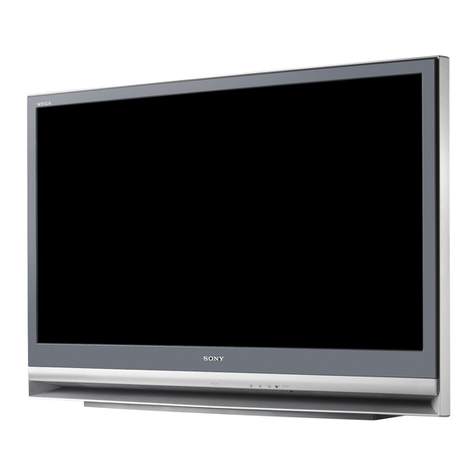
Sony
Sony KDF50E2000 - 50" Rear Projection TV operating instructions
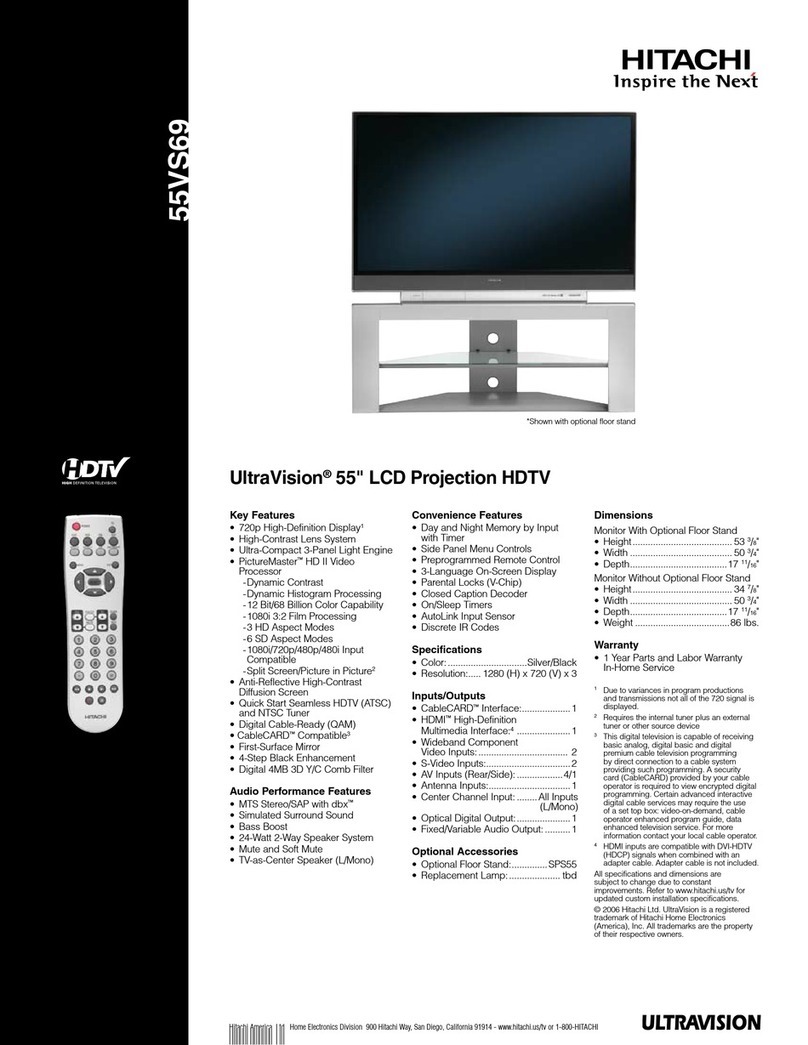
Hitachi
Hitachi 55VS69A Specifications
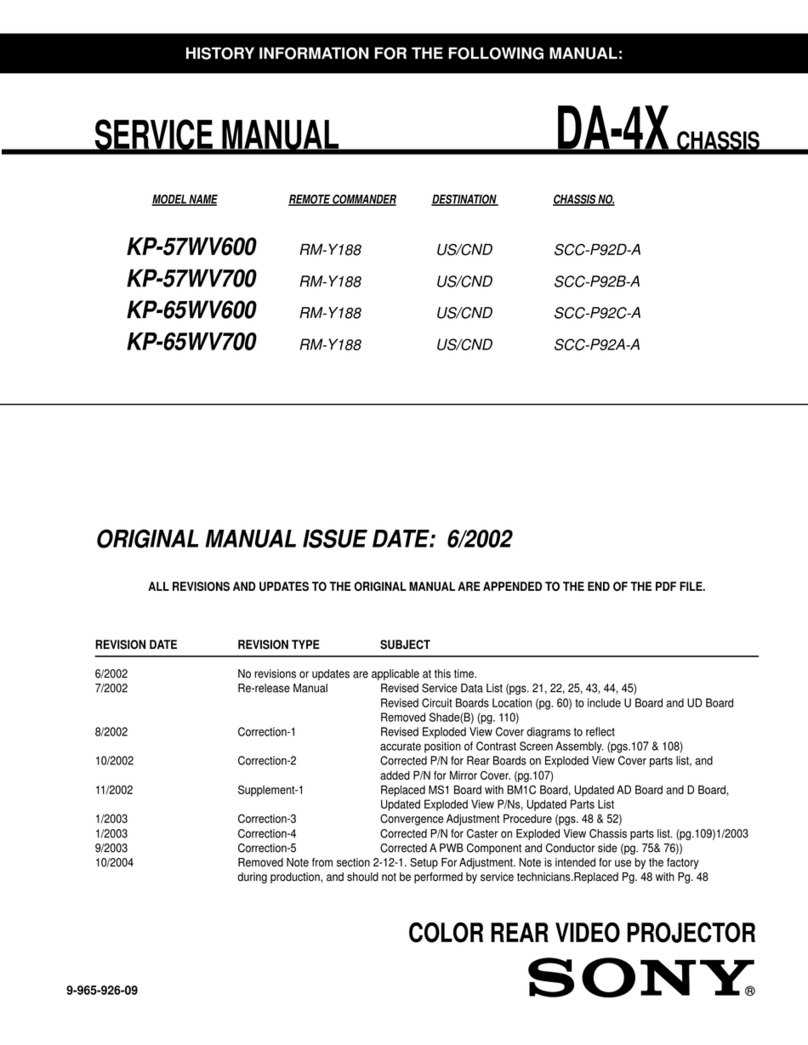
Sony
Sony KP-57WV600 - 57"hi-scan 1080i 16:9 Projection... Service manual
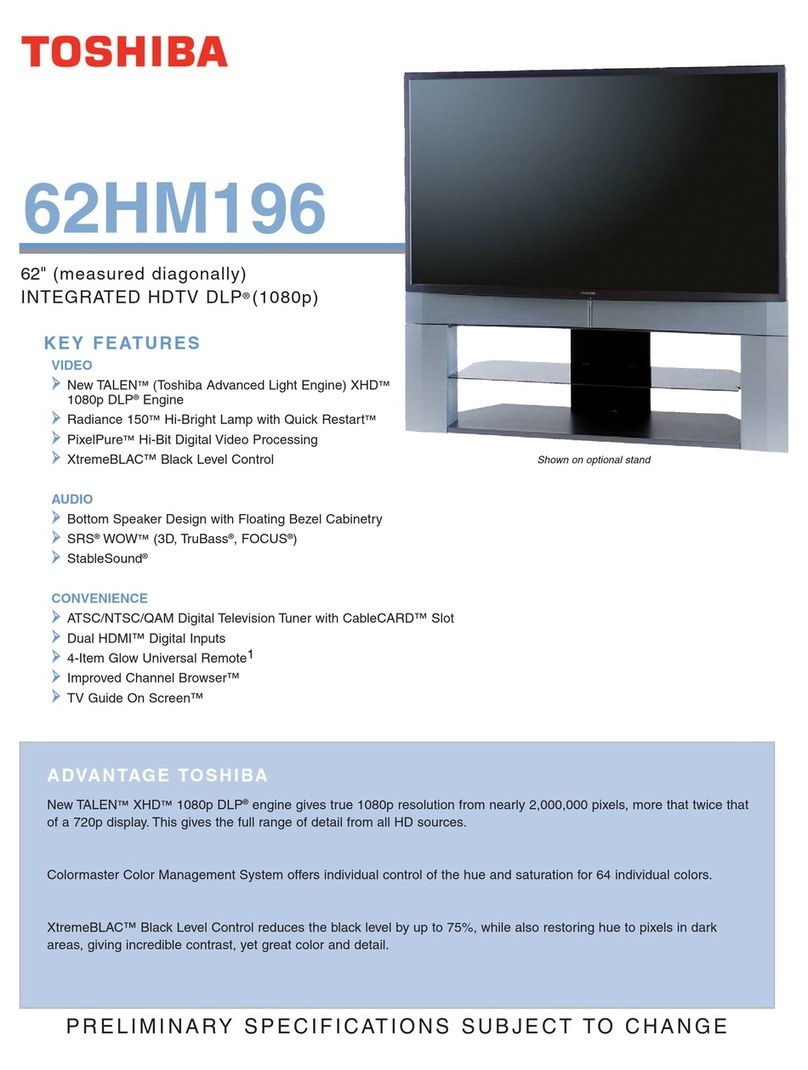
Toshiba
Toshiba 62HM196 specification
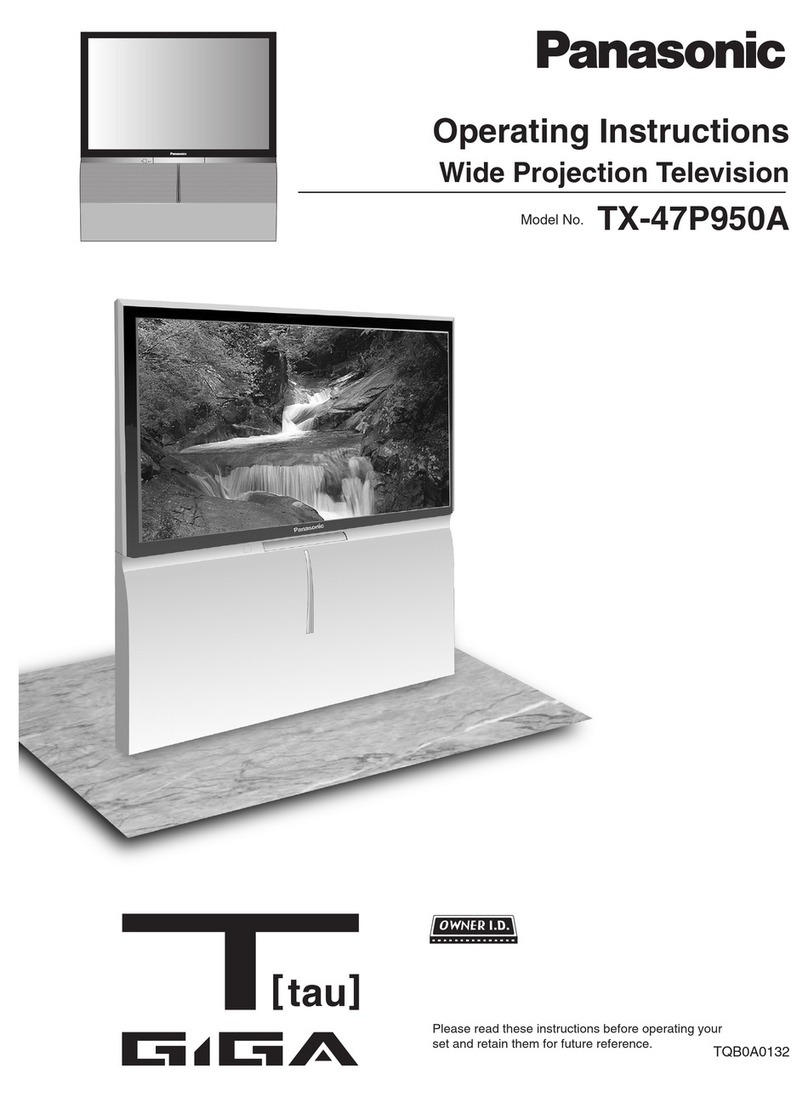
Panasonic
Panasonic TX-47P950A operating instructions

Philips
Philips 51PP9303H/17B Quick use and setup guide
